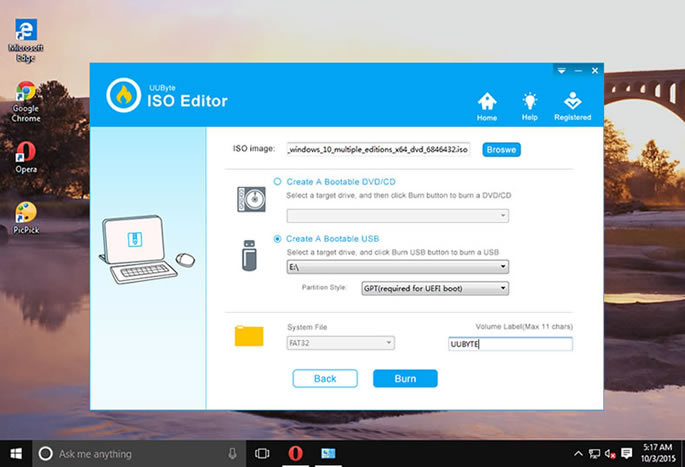


- CREATE A BOOTABLE USB ON MAC FOR WINDOWS 10 INSTALL
- CREATE A BOOTABLE USB ON MAC FOR WINDOWS 10 WINDOWS 10
- CREATE A BOOTABLE USB ON MAC FOR WINDOWS 10 ISO
Once done, we’re finished with the OSX side. We’ll wait for it to copy, this will take some time. We’ll type “ cp -r ~/Desktop/Windows10/* /Volumes/ESD-USB/”. Next, we’ll copy our files to our newly formatted flash drive. You can do this from Disk Utility or via Terminal by typing ” diskutil erasedisk fat32 “ESD-USB” MBR disk4”. Now we need to format our flash drive to FAT32. Then delete install.wim from the Windows10\Sources folder. This is much like copying files, it will take some time to process. This will split our wim file into two files labeled “ xaa” and “ xab”.

It’s important to follow the syntax exactly, the m for “Megabyte” must be lower case. We’ll type, “ sudo split -b 3000m install.wim”. Remember, we need to get the file size under 4GB for FAT32. The prompt should confirm you’re in the sources folder. Open terminal and type: “ cd Desktop\Windows10\Sources”. Now, we need to navigate to this new folder where the files were copied via terminal. Type: “ cp -r /Volumes/CCOMA_X64FRE_EN-US_DV9/* ~/Desktop/Windows10/”. You can do this in finder, or via terminal.
CREATE A BOOTABLE USB ON MAC FOR WINDOWS 10 ISO
From here, we’ll copy the files from the mounted ISO file. I created a folder on the desktop called “ Windows10”. In this guide we’re going to focus on doing this in a way that does not use third party tools to split the wim file.įirst we’ll need to create a folder to store our installation files. If you followed the guide above and your flash drive wasn’t detected, apparently your motherboard cannot boot from an ExFAT partition.
CREATE A BOOTABLE USB ON MAC FOR WINDOWS 10 INSTALL
We’re booting UEFI in this guide.įrom here, you’re just doing a normal clean install of Windows 10. If not, you’ll need to use the boot menu key and select the flash drive from there. From here, you’re just doing a normal clean install of Windows 10. If this is a new build with an empty drive, it should boot automatically. Finally eject the flash drive, connect it to your computer and power it on. It’s important to note there is not status indicator here, you’ll get a flashing cursor. Let the files copy, this will take up to 20 minutes. We’re using the copy command (cp) with the switches recursive (to copy all sub directory files) and p (Preserves file attributes). Type “ cp -rp /Volumes/CCCOMA_X64FRE_EN-US_DV9/* /Volumes/ESD-USB/”. It will mount as CCCOMA_X64FRE_EN-US_DV9. Double click the ISO we downloaded earlier to mount it. Now we need to copy our installation files. If this is not the case, correct the number on the end. Once you’re sure, type “ diskutil erasedisk exfat “ESD-USB” MBR disk4” with disk4 being your flash drive. Be careful, you do not want to wipe the wrong drive. Verify this by the volume name and capacity. In the image below we see our drive is disk2.

Type “diskutil list” to list your drives. You can open Terminal from the Utilities. I will detail the command via terminal below. You can do this in Disk Utility or via Terminal. You’ll need to format your flash drive as exFAT. I’ve also tested some Asrock boards with Intel chipsets that worked just fine as well. If you’ve got a new ASUS board with an Intel chipset, you’re more than likely not going to have a problem with exFAT.
CREATE A BOOTABLE USB ON MAC FOR WINDOWS 10 WINDOWS 10
You can download the latest version of Windows 10 here: Unfortunately, neither of these tools are available to us on OSX without setting up a virtual machine. DISM.exe also has ability to split and combine wim files. Their media creation tool will format your flash drive FAT32 and split the wim file for you. FAT32 will work, but it’s limited to a maximum file size of 4GB, and at this point the install.wim file on the current version of Windows 10 is too large for this file system and this is the main hurdle. Mainly the age of the system, and whether the motherboard can boot to certain file systems. The methods vary based on a couple of factors. This is a guide on various methods of creating installation media on OSX.


 0 kommentar(er)
0 kommentar(er)
